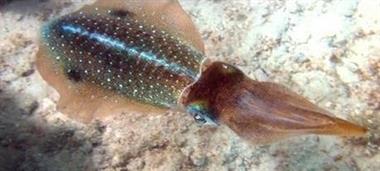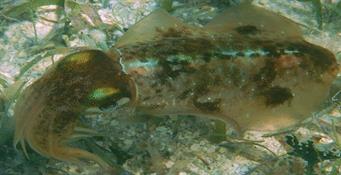



Sepioteuthis sepioidea
Size
To 30cm
Description:
Most common squid in Antigua. Oblong mantle bordered along its length by a transparent/ translucent fin, forming a point at the rear. Frequently change colours and patterns - brown to white to reddish, often with blue and green highlights. The head is slightly pointed to its anterior end, with eight arms and two tentacles which encircle the mouth. Suckers are positioned along the inner region of arms and tentacle clubs. The mantle is fleshy when relaxed and the skin is very fragile.
Ecology
An epipelagic and pelagic species, often in groups. The depth and habitat they are observed at depends on their growth stage. Newly hatched squid are found within 20-100cm (8-36") beneath surface, and can be about 10m (30ft) above the sea bottom, in a habitat of sand, debris, coral and little vegetation . The habitat of older juveniles involves turtle grass (Thalassia testudinum) flats in relatively shallow areas. Medium-sized and non-breeding adults tend to be found more at mid-depth, while breeding squid are closely
affiliated with coral reef habitats. It exhibits both diurnal and nocturnal activity.
Individuals feed mostly on small fish and arthropods. During the day, individuals hunt in schools but feed one at a time, whereas during the night time they hunt and feed alone. They identify prey based on visualization and use a number of strategies to successfully acquire prey, including luring them by changing posture, arm positions and skin colour patterns.
Colour patterns of the skin can change periodically, via light-reflective and iridescence-inducing cells.
Life Cycle
Reproduction occurs following copulation in the form of egg laying. Multiple offspring are produced after eggs hatch but there is no parental care.
To 30cm
Description:
Most common squid in Antigua. Oblong mantle bordered along its length by a transparent/ translucent fin, forming a point at the rear. Frequently change colours and patterns - brown to white to reddish, often with blue and green highlights. The head is slightly pointed to its anterior end, with eight arms and two tentacles which encircle the mouth. Suckers are positioned along the inner region of arms and tentacle clubs. The mantle is fleshy when relaxed and the skin is very fragile.
Ecology
An epipelagic and pelagic species, often in groups. The depth and habitat they are observed at depends on their growth stage. Newly hatched squid are found within 20-100cm (8-36") beneath surface, and can be about 10m (30ft) above the sea bottom, in a habitat of sand, debris, coral and little vegetation . The habitat of older juveniles involves turtle grass (Thalassia testudinum) flats in relatively shallow areas. Medium-sized and non-breeding adults tend to be found more at mid-depth, while breeding squid are closely
affiliated with coral reef habitats. It exhibits both diurnal and nocturnal activity.
Individuals feed mostly on small fish and arthropods. During the day, individuals hunt in schools but feed one at a time, whereas during the night time they hunt and feed alone. They identify prey based on visualization and use a number of strategies to successfully acquire prey, including luring them by changing posture, arm positions and skin colour patterns.
Colour patterns of the skin can change periodically, via light-reflective and iridescence-inducing cells.
Life Cycle
Reproduction occurs following copulation in the form of egg laying. Multiple offspring are produced after eggs hatch but there is no parental care.

| Ecological Descriptors | ||||
| Habitat | Size (cm) | Diet | Behaviour | Sex |
| EpiPel Pel |
30 | Pisc (Car) | I, Sh | F |

Caribbean Reef Squid

(C) JCVdude

Caribbean Reef Squid

274

